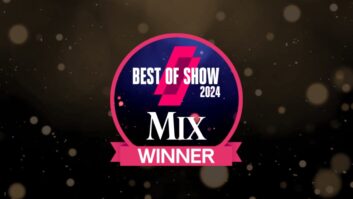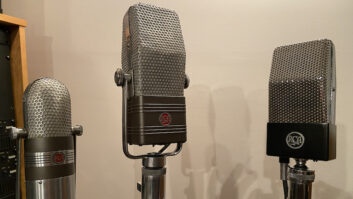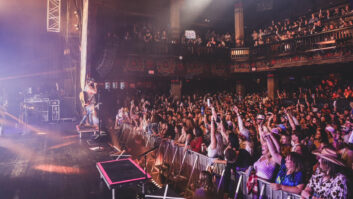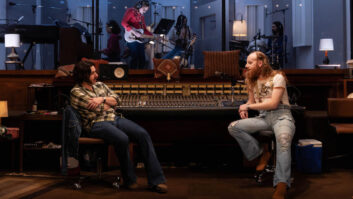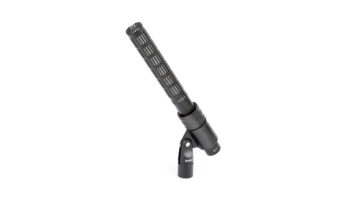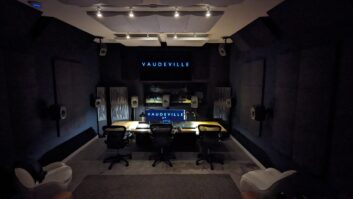Hideaway Studio’s control room, which measures roughly 16×19 feet, features plenty of outboard gear but no console. Joe Mabbott, owner of Minneapolis, Minnesota-based The Hideaway Studio, which opened back in 2004, says that during the mid- 1990s, Minneapolis had more recording studios per capita than anywhere else in the U.S. Ironic for a city whose temperatures during the winter months average well below 20 degrees Fahrenheit. “The cold up here helps studios survive, because people get creative in the winter and there is nothing to do outside unless you’re into ice fishing,” observes Mabbott. “So we turn indoors and create music. We do a lot of records in the winter months and try to take time off in the summer.”

The music scene in Minneapolis has evolved and changed very dramatically, having a corollary effect on the local studio market. “There were a ton of studios out here, but with the demise of the record industry, many have closed their doors,” says Mabbott. This has made room for more mid-sized studios like The Hideaway, which has roughly 4,000 square feet and consists of two large tracking spaces and a single control room.
Even though the record industry has suffered, Mabbott says that the live scene in Minneapolis is vibrant and very alive. “There are plenty of big acts that come through here,” he says. Local arenas as well as legendary Minneapolis clubs such as First Avenue and Seventh Street Entry are among the busy venues in the area that help create a steady draw for the studio. “I get people off of tours that need a place to record, and there are also a ton of local acts that are doing very well on the national scene,” he says.
To survive in the Minneapolis studio market, Mabbott says it’s important to know your strengths and maintain focus. “My studio is pretty well known for hip-hop and Irish music. Having a focus on these areas have really helped create an interesting niche,” Mabbott points out. While much of its work centers on these two unique genres, the studio hosts a wide range of styles. “I work on anything: for example, this week, I’ve done a 20-piece Irish bagpipe group, a hip-hop group, a jazz fusion group and a rock group.”
The Hideaway Studio is situated in an old warehouse building on the site of a former brewery. The live room is a generously sized at 25×35 feet with 14-foot ceilings; Mabbott loves its openness and airy feel. “It is a very flexible room that can accommodate a lot of people,” he observes. “Half of the room is concrete and exposed brick, and the other half sheetrock and sound-treated so I can really get the ambience if I want it.” For tracking purposes, The Hideaway Studio has two rooms in addition to the main live room at its disposal—the vocal booth, which at 9×14 feet can easily accommodate a drum kit or an isolated bagpiper, and a medium-sized room measuring 11×20 feet, largely comprised of reflective tile. “The tile room used to be a cafeteria for the brewery, so we exposed it and now it is a nice, open room. I’ll record drums or guitars in there—anything that needs a big, washed-out rock sound.”
When he is tracking bagpipes in the live room, Mabbott says that it is all about mic placement. “With the 15 pipers, I am usually just doing a spot mic here and there to catch the ambience of the entire group.” Generally, he uses a Neumann TLM 149 tube condenser for this, along with a few Violet Design mics to spot the snare drums. On bass drum, he’ll use a Shure Beta 52 dynamic. Other choices in his mic closet include a pair of Neumann KM 84s, a U 87, a U 89 a TLM 103 and plenty of mics from Sennheiser, AKG, Audio-Technica and Fat Head ribbon mics from Cascade. “For the vocal miking, I’d say that the Neumann TLM 149 gets the most use,” Mabbott reports. “I would put that mic up against any other mic that we have. There is just something about the characteristic in the mids that help the vocal stick out in the mix. It also requires a lot less messing around in the mix to make it right.”
The control room, which measures roughly 16×19 feet, features plenty of outboard gear but no console. “For me, it was an ergonomic decision not to have a console,” recalls Mabbott. “Earlier in 2011, I remodeled the entire control room, got rid of the console and decided to go with a mastering-style desk instead.” Mabbott has collected quite an impressive collection of diverse preamplifiers, all of which run into his Avid Pro Tools|HD3 system. Among these are Great River, API, Telefunken, Aurora Audio and others. “I chose my preamplifiers based on their versatility and tone,” he says. “Each serves a purpose for whatever it is I am trying to record.”
Since opening nearly eight years ago, The Hideaway Studio has relied strictly on word of mouth to sustain its business. “The records I’ve done speak for themselves, and I get work that way,” Mabbott explains. “Now I am trying to get more outside engineers and producers to come in and use the space. This music scene here breeds a lot of talented producers and engineers that need a place to work. My doors are wide open for those people.”
The Hideaway Studio
thehideawaympls.com
